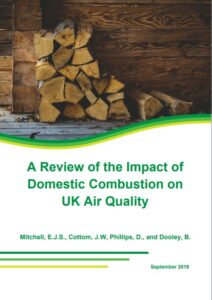Scientific review casts doubt on impact of domestic burning
17 December 2019
 Scientific review casts doubt on impact of domestic burning
Scientific review casts doubt on impact of domestic burning
The findings of a new independent scientific review commissioned by HETAS and supported by the Stove Industry Alliance (SIA), have drawn attention to the uncertainty around how much domestic burning in people’s homes contributes to UK air pollution.
The Clean Air Strategy 2019 currently attributes 38% of UK particulate matter emissions to the domestic burning of solid fuel, including wood. However, scientists now believe this is highly likely to have been overestimated in that the figure encompasses a wide range of burning not associated with home heating and stoves. The figures include commercial catering, bonfires, BBQ’s, fire pits, wildfires and so on. A recent report calls for more research and use of modern test equipment and techniques to differentiate between the various sources of emissions.
HETAS, supported by the SIA, commissioned a critical review to better understand current particulate matter emissions estimates and highlight the need for more accurate evidence-based information to be gathered. This will help the industry and Government to prioritise resources and take action to reduce emissions from the highest emitting sources.
Woodsure members can access the full report by contacting the team at [email protected]
The review reveals uncertainties of the existing data and evidence used to estimate the figure reported in the Clean Air Strategy, suggesting it is highly likely to be inaccurate. It also highlights that without accurately defining the highest contributing sources and taking targeted action, the 2030 emissions reductions obligations of the NEC Directive are unlikely to be met.
A Review of the Impact of Domestic Combustion on UK Air Quality
Key findings:
- Previous studies may not have considered the wide and varied sources of biomass burning i.e. unregulated domestic burning (chimineas/ firepits, garden waste bonfires, outdoor cooking) and prescribed burning (agriculture and land management)
- Current estimates are based on older reports and findings that used older equipment, relying on chemical indicators that are present in emissions from many different biomass burning sources.
- The weight of wood fuel used in the UK and the application of an estimated emissions factor for this weight have likely been overstated
- Open fires and old wood burning stoves may be responsible for up to half of the attributable PM emissions and need to be replaced with modern Ecodesign Compliant cleaner-burning stoves
Bruce Allen explains:
This review strongly suggests the need for more accurate research. This will enable HETAS and the broader industry to support the government in driving consumer awareness in the right areas to minimise the impact of domestic burning in the home. In the meantime, there are practical steps that can be taken to immediately reduce emissions in the home by up to 80%, compared to burning coal in an open fire. All appliances burn more cleanly with the right fuels which are smokeless mineral fuels and dry Ready to Burn wood. If burning in a smoke control area, only smokeless fuels and exempt appliances with dry wood are allowed. It’s important that we continue to work with installers and chimney sweeps to get this message across and raise the awareness of the need for safe, efficient and environmentally responsible burning.
HETAS guide to responsible burning:
- Choose a modern, HETAS and Defra approved Ecodesign Compliant stove which burns safely and efficiently
- Burn properly seasoned or kiln dried wood marked Woodsure Ready to Burn. It won’t smoke as much as other fuels and will give you a long-lasting, warm burn
- Keep the appliance and chimney clean and well maintained with regular checks from trusted HETAS Approved Chimney Sweeps and servicing technicians
- Always use an appliance in accordance with the manufacturer’s instructions